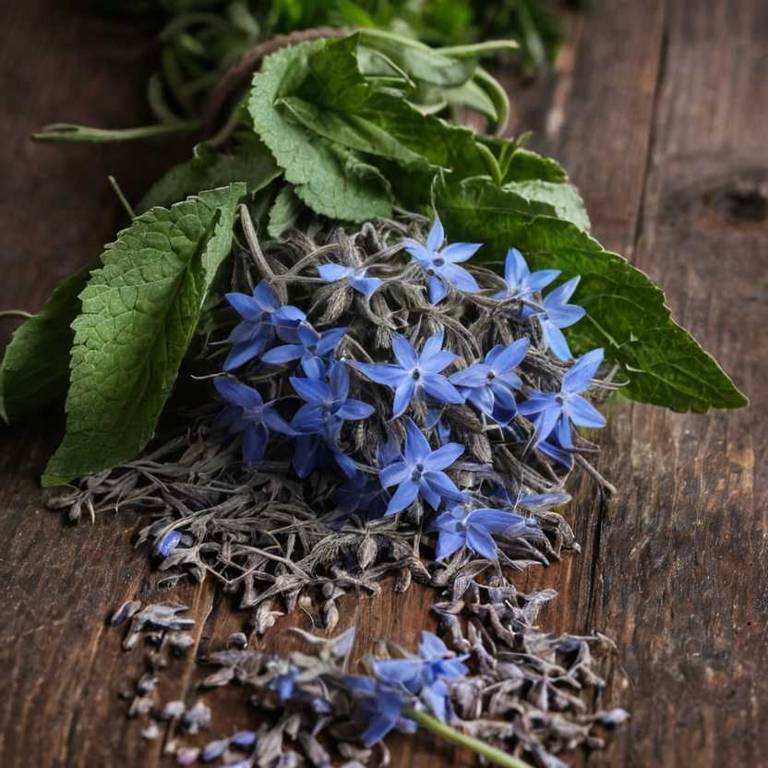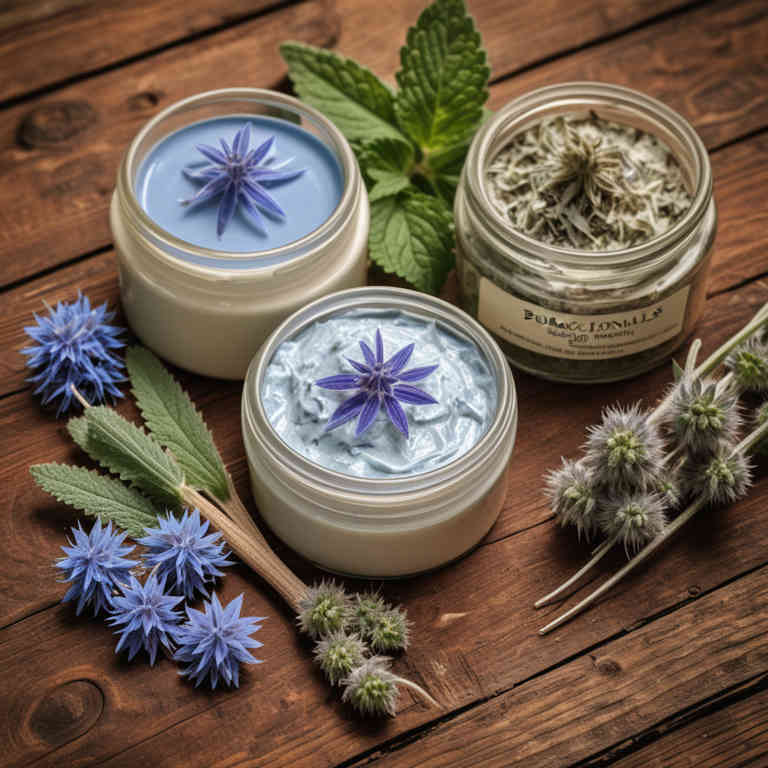10 Best Borago Officinalis Preparations

The best medicinal preparations of Borago officinalis are teas, decoctions, tinctures, mucillages, and oils, each offering unique therapeutic benefits.
Teas made from the leaves are commonly used to soothe digestive issues and promote relaxation.
Decoctions involve boiling the dried plant material to extract its active compounds, often used for respiratory support.
Tinctures, prepared with alcohol, provide a concentrated form of the herb’s medicinal properties.
Mucillages, derived from the seeds, are used as a demulcent to ease inflammation and irritation in the digestive tract.
Oils extracted from the seeds are valued for their skin-soothing and anti-inflammatory effects.
Below there's a list of the 10 best herbal preparations of borago officinalis for medicinal purposes.
- 1. Teas
- 2. Decoctions
- 3. Tinctures
- 4. Mucillages
- 5. Oils
- 6. Creams
- 7. Syrups
- 8. Capsules
- 9. Lozenges
- 10. Oinments
1. Teas
Borago officinalis teas is commonly used to treat digestive issues, inflammation, and skin conditions.
This herbal preparation is often employed for ailments such as indigestion, gastritis, and eczema due to its soothing and anti-inflammatory properties. The most common medicinal uses include alleviating gastrointestinal discomfort and promoting skin healing. The bioactive constituents responsible for these effects include gamma-linolenic acid (GLA), flavonoids, and mucilage.
These compounds contribute to its anti-inflammatory, antioxidant, and emollient properties.

2. Decoctions
Borago officinalis decoctions is commonly used to treat respiratory and digestive ailments, as well as skin conditions.
These decoctions are often employed to alleviate symptoms of coughs, bronchitis, and inflammation due to their anti-inflammatory and expectorant properties. They are also used to relieve digestive issues such as indigestion and bloating. The bioactive constituents responsible for these effects include mucilage, flavonoids, essential oils, and tannins, which contribute to their soothing and healing properties.
Additionally, the presence of omega-3 fatty acids may support immune function and reduce inflammation.

3. Tinctures
Borago officinalis tinctures is commonly used to treat digestive issues, skin conditions, and respiratory ailments.
These tinctures are often employed to alleviate symptoms of indigestion, inflammation, and coughs. The most common medicinal uses include soothing skin irritations, reducing inflammation, and supporting digestive health. Bioactive constituents such as flavonoids, mucilage, and essential oils contribute to its therapeutic effects.
These compounds help reduce inflammation, protect mucous membranes, and promote healing.

4. Mucillages
Borago officinalis mucillages is commonly used to treat digestive issues, skin conditions, and inflammatory disorders.
The mucillages, which are rich in polysaccharides, form a gel-like substance when mixed with water, providing soothing and protective effects on mucous membranes. Common medicinal uses include alleviating symptoms of gastritis, ulcers, and irritable bowel syndrome, as well as treating eczema and minor burns. The bioactive constituents responsible for these effects include mucilage polysaccharides, which have emollient, anti-inflammatory, and antioxidant properties.
Additionally, the presence of flavonoids and phenolic compounds contributes to its therapeutic benefits.

5. Oils
Borago officinalis oils is commonly used to treat skin conditions, digestive issues, and respiratory ailments.
The oil is often applied topically for its anti-inflammatory and wound-healing properties, and it may also be ingested in small amounts to relieve gastrointestinal discomfort. It is also used in aromatherapy to alleviate stress and promote relaxation. The most common medicinal uses include treating eczema, psoriasis, and other inflammatory skin disorders, as well as aiding digestion and reducing coughing.
The bioactive constituents responsible for these effects include gamma-linolenic acid (GLA), which has anti-inflammatory properties, and other essential fatty acids, antioxidants, and phytoestrogens.

6. Creams
Borago officinalis creams is commonly used to treat skin conditions and reduce inflammation.
These creams are often applied topically to alleviate symptoms of eczema, psoriasis, and other inflammatory skin disorders. The medicinal properties of Borago officinalis are attributed to its bioactive constituents, including essential fatty acids, flavonoids, and mucilage. These compounds have anti-inflammatory, antioxidant, and soothing effects on the skin.
Additionally, the plant's oil is sometimes used to promote skin hydration and healing.

7. Syrups
Borago officinalis syrups is commonly used to alleviate respiratory conditions, such as coughs and bronchitis, due to its expectorant properties.
This herbal preparation is also used to treat skin irritations and wounds because of its anti-inflammatory and antimicrobial effects. The most common medicinal uses include soothing respiratory tract inflammation, promoting wound healing, and reducing skin infections. The bioactive constituents responsible for these effects include mucilage, flavonoids, and essential oils, which have demulcent, antioxidant, and antimicrobial properties.
These compounds work together to provide the therapeutic benefits associated with Borago officinalis syrups.

8. Capsules
Borago officinalis capsules is commonly used to support digestive health, reduce inflammation, and promote skin healing.
They are often employed to treat ailments such as digestive disorders, skin conditions like eczema, and inflammatory conditions. The bioactive constituents responsible for these effects include gamma-linolenic acid (GLA), which has anti-inflammatory properties, along with flavonoids and mucilage that contribute to its soothing and protective effects. Additionally, the plant contains essential fatty acids and antioxidants that support overall wellness.
These components work synergistically to provide the medicinal benefits associated with Borago officinalis.

9. Lozenges
Borago officinalis lozenges is commonly used to soothe sore throats, reduce inflammation, and alleviate symptoms of respiratory conditions such as coughs and colds.
These lozenges are often employed in the treatment of sore throats, bronchitis, and other inflammatory conditions affecting the upper respiratory tract. The bioactive constituents responsible for these medicinal effects include mucilage, flavonoids, and essential oils, which possess anti-inflammatory, antimicrobial, and expectorant properties. Additionally, the plant contains tannins that contribute to its astringent effects, helping to reduce irritation and promote healing.
Due to its soothing and protective qualities, Borago officinalis lozenges are a popular natural remedy for throat and respiratory discomfort.

10. Oinments
Borago officinalis oinments is commonly used to treat skin conditions, inflammation, and pain.
These oinments are often applied topically to alleviate symptoms of eczema, psoriasis, and other dermatological issues. They are also used to reduce swelling and discomfort associated with muscle strains and joint pain. The bioactive constituents responsible for these effects include gamma-linolenic acid (GLA), which has anti-inflammatory properties, and other essential fatty acids that support skin health.
Additionally, the presence of flavonoids and mucilage contributes to its soothing and healing effects on the skin.
